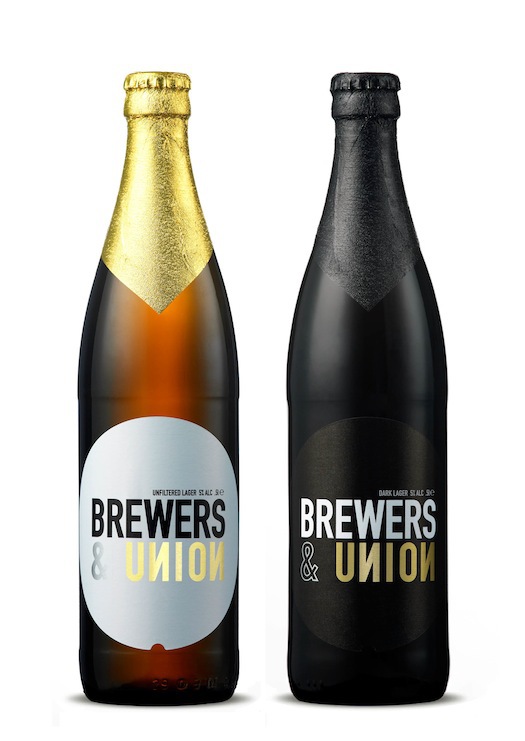
Cape Town's local brew, brought to you by a waitress on Long Street. Courtesy &Union.
On the eve of the Design Indaba conference in Cape Town, South Africa, I took myself out for a fish burger. The server recommended a local beer and brought an excellent dark lager. Its name, Brewers &Union, winked with inverted “N’s” in a restrained sans-serif logo that might have been a distant homage to M&Co.’s upside down “A’s” for the Talking Heads’ album Remain in Light.
Two days later, I saw the label again. This time, it was projected on a screen on the Indaba’s stage. Standing before it, Brad Armitage and Rui Esteves, men who had brought high-end coffee shops to Cape Town, were discussing their venture into artisanal beer. Not content with bottling the beer in nice packages, they had opened a bar in which to serve it and chose as their venue a church basement. This spot of perversity — an echo of the logo’s twisted “N’s” — required that they remove the sacrilegious word “Brewers” from the establishment’s wall, leaving "&Union" to carry the brand.
Maybe soaking in the African sunshine after a grim New York winter had some effect, but I found Cape Town not just cheerful this Indaba, but even high on design. The city’s role as co-host of last year’s FIFA World Cup has left it with a capacious new stadium where U2 performed a week before I arrived. A thoroughfare known as the Fan Walk is waking up pedestrian street life much as the High Line has done in New York. My hotel, so cool and slick it might have been beamed down from Tokyo, is a recent arrival, as is the downtown art hotel that includes an Airstream trailer park on its roof. Little wonder that Cape Town is bidding for World Design Capital 2014. Or that you can’t pick up a bottle of beer in this place without finding a label worthy of presentation at a prestigious international design conference.
And yet, though it batted well for the home team, &Union was in the minority on the Indaba stage simply because it focused on commerce. Clustered with two other case studies of creative entrepreneurship (including the hotel-with-trailer-park built by Cape Town–based Jody Aufrichtig and Nick Ferguson of Daddy’s World), &Union contrasted with the many presenters who emphasized social change. The Design Indaba is a talent magnet, attracting the likes of Stefan Sagmeister, Terence Conran and Martha Stewart to South Africa. This year’s designer parade kicked off with Michael Wolff, co-founder of Wolff Olins, and ended with Robert Wong, Google’s creative director. Michael Bierut replayed the role of master of ceremonies. Yet the traditional division between visiting eminences and local talent was realigned. &Union and Daddy’s World belonged to the same category of speakers as Dana Arnett, who has maintained long, loving relationships with IBM and Harley-Davidson, and David Butler, creative director of Coca-Cola in Atlanta and this Indaba’s only out-and-out flop. (Exhorting the audience to add value to business through systems thinking, which he illustrated with banal drinks dispensers throughout the world, Butler managed to be both condescending and unconvincing. The tea-table chatter at break time was scathing.)
On the other side of the divide were the do-gooders, and a wildly diverse bunch they were. David Kester, chief executive of the U.K. Design Council, led a session about initiatives to improve public health in Britain though such means as replacing a pub’s glass mugs with plastic (thereby reducing lacerations in brawls) and making hospital furniture and bedding more hygienic. One of Kester’s partners in the latter endeavor, the industrial designer Luke Pearson, who is better known for stylish aircraft seating and office chairs, displayed concepts for improved hospital commodes. Deborah Szebeko, founder of Thinkpublic in London, discussed service-design initiatives to assist the users of public amenities, such as housing and healthcare, while streamlining the financial burden such services impose on the state.
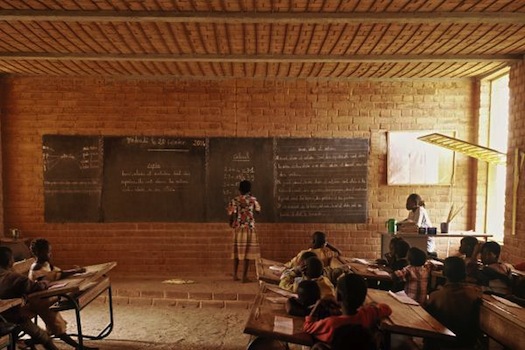
Francis Kéré, interior, Gando primary school, Burkina Faso.
Compared with audiences at TED, and all of Broadway theater for that matter, Indaba delegates are stingy with standing ovations. So it was a big deal when they gave one to Francis Kéré an architect who splits his time between his native Burkina Faso and Germany. Aided by villagers, Kéré built a sorely needed schoolhouse with local materials (compressed earth bricks) and traditional construction methods (pounding the floors smooth with brooms). This project was recently displayed at MoMA's exhibition "Small Scale, Big Change: New Architectures of Social Engagement." Another favored speaker, the Israeli-born New York designer Dror Benshetrit, debuted his QuaDror building system. A configuration of interlocking metal pieces with astonishing stability and strength for the small amount of material used, QuaDror offers potential for constructions at any scale, from furniture to emergency shelters.
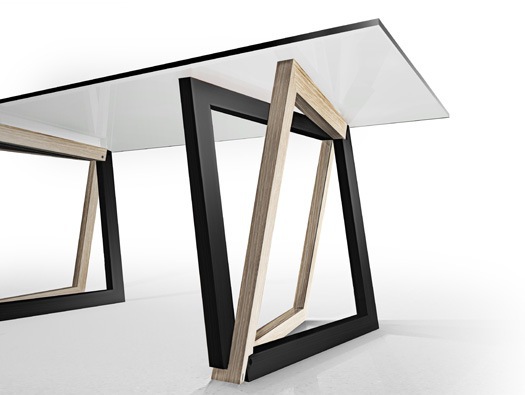
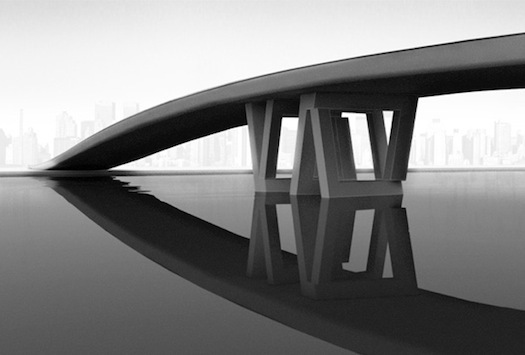
Dror Betshetrit, QuaDror structural members at two scales.
Among South African speakers the crowd showed the most love to Laduma Ngxokolo, lately a student at Nelson Mandela Metropolitan University in Port Elizabeth, who presented men’s mohair knitwear with prints based on the motifs of Xhosa initiation rites. The Twitter feed soon buzzed with hopes for a women’s collection. Ngxokolo was one of seven recent design school graduates who presented in Pecha Kucha style at the Indaba. Among the others, two were from the U.S. (Lindsay Kinkade and Joe Saavedra), one from Canada (Christine Goudie), and three from Europe (Camille Blin, Dirk van der Kooije, and Nelly Ben Hayoun). Half of these young speakers unveiled projects directly concerned with social change.
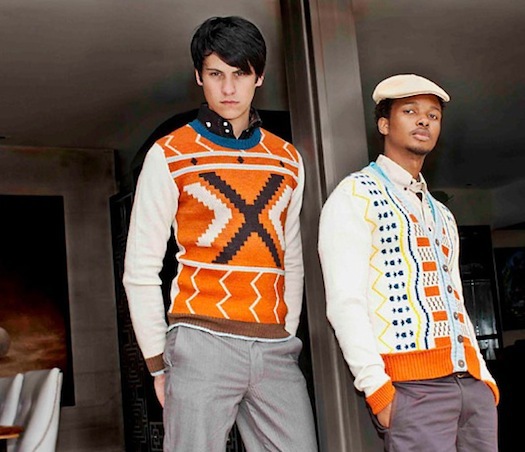
Laduma Ngxokolo, mohair knitwear based on Xhosa designs.
Social activism also embroidered the work of established cultural forces such as Droog co-founder Renny Ramakers, whose “Saved by Droog” exhibition in Milan last year displayed the work of 14 designers invited to create new products from goods (chairs, wallets, life vests) sourced from bankrupt companies. Ramakers recently visited Mumbai and was impressed by the vitality of the informal economy there. She announced a new project, MakeMe, which she described as a “high-quality curated platform for downloading design” that would feature a “network of producers, 3D printers and craftsmen from all over the world.”
Indeed, appropriate to both South African heritage and our particular moment in world history, much stage time was given to the revitalizing power of craft — both low-tech craft as practiced by Carla Fernández’s Taller Flora women’s fashion collective in Mexico and high-tech as embodied by philanthropist Mark Shuttleworth’s open-source development of the Ubuntu operating system.
I alluded above to a divide between business and goodness, but at the Design Indaba, as everywhere else, such boundaries are ultimately spurious. Just as Shuttleworth and Kester emphasized the economic benefits of their humanitarian approaches, the Indaba’s business tales had a strong degree of heart. One might expect this from sympathetic old pros like Michael Wolff, who came across as a British Yoda with a bottomless supply of gentle wisdom (Don’t trust experience because it gets in the way of creative exploration, he urged), or like Alberto Alessi of postmodern teakettle fame, who is Italian, and therefore charming by default. But Jen Bilik, the California-based founder of paper goods company Knock Knock, took everyone by surprise. In a riotously funny yet painfully raw talk, Bilik recounted managing every detail of her venture, from product conception to manufacturing to sales. “Any regrets?” Bierut asked. “My thirties,” Bilik said with whiplash timing. Entrepreneurship had left little room for a personal life, she explained: “I forgot to have children.…My dating life went out the window, along with my figure.”
In general, the audience responded to the deep personal currents running through presentations. Richard Hart, of the Durban design studio Disturbance, began with an animated autobiography crammed with details of his Scottish birth, parental infidelity, relocation to Africa, military service, and surfing. It was as winning as a miniature kinetic version of David Copperfield. The Dutch designer Maarten Baas asked all 1,000-plus people in the auditorium to sing “Happy Birthday” to his absent mother and filmed the obliging chorus. Robert Wong, who appears to be a kindly personification of Google’s “don’t be evil” mandate, began with a warm tribute to his wife and young children, who were present. Having spent much of his life trying to make his parents proud, Wong confided, it had come as a revelation that his goal was now to impress his kids.
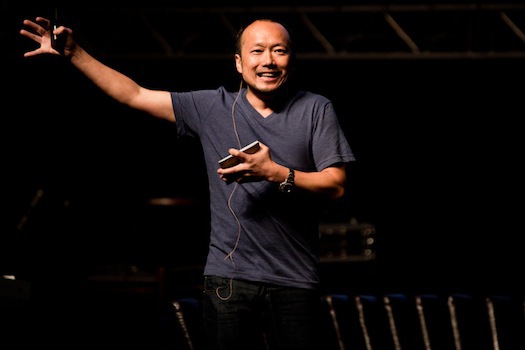
The opposite of evil: Google's creative director Robert Wong.
Almost every other presenter, it seemed, shared family pictures. So much so that one speaker even admitted to inserting a few into his slide show at the last moment. Suffice it to say that if you were left with any questions about Massimo Vignelli after Design Observer’s extensive coverage last fall in honor of his 80th birthday, I can assure you he was a beautiful baby. That much was made clear in the images accompanying Bierut’s Indaba tribute to his former boss, who was there to appreciate it.
In presenting all that I’ve described and much more, the Indaba revealed, if revelation is needed, how flat the design world has become. Is there a lesson in any place, on any scale, in any design genre or medium that does not have some pertinence for everyone? The answer heard all the way from Cape Town was a resonant and joyous no.


Comments [2]
Cheers to the Design Indaba people knowing you..
A.
03.08.11
12:42
. . . and some would say there is a lightning bolt in the figure ground of the inverted “N” and the “W” of BREWERS . . . &Heaven is a place where nothing ever happens. Thank you Julie
03.09.11
12:18